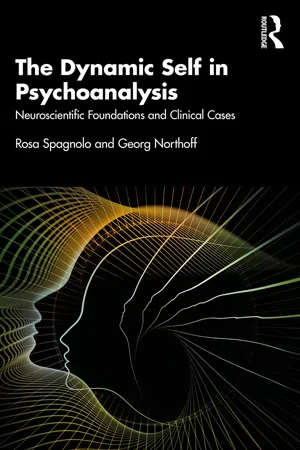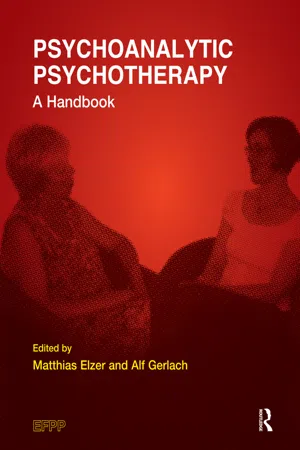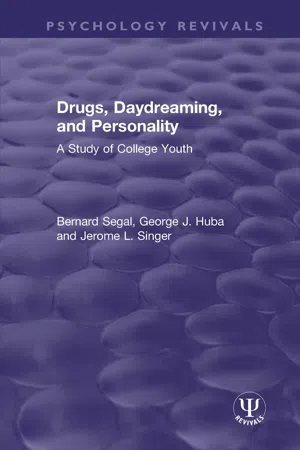Dreaming
Dreaming is a complex mental process that occurs during sleep, involving vivid sensory experiences, emotions, and thoughts. It is characterized by the presence of vivid, immersive imagery and a suspension of critical thinking. Dreaming is believed to serve various psychological functions, such as processing emotions, consolidating memories, and problem-solving.
7 Key excerpts on "Dreaming"
- eBook - ePub
Awareness
Biorhythms, Sleep and Dreaming
- Evie Bentley(Author)
- 2020(Publication Date)
- Routledge(Publisher)
...In his overview of this area, Empson (1993) has pointed out four main differences between these two states: We are the spectators of our dreams, we do not consciously control them. Lucid Dreaming is an example of being a spectator. Normal logic simply does not apply in dreams. Normal dreams are rich, varied and bizarre compared to dreams monitored in a laboratory setting. This ' laboratory effect' means that much of our research-data lacks ecological validity. Dreams contain hallucinations, delusions, amnesia, and exclude the awareness of lots that is going on and streams of consciousness which we have when awake. Summary Dreams fascinate humanity. Psychologists have proposed a variety of theories to account for why we dream. The four neurobiological theories are: Hobson and McCarley's theory that the random firing of brain neurones is given meaning by your mind (activation and synthesis). Oswald's restoration model which ties Dreaming in with replenishing neurochemicals in the brain. Crick and Mitchison's theory that sees Dreaming as a garbage-disposal effect where the brain seeks out and destroys unwanted or faulty connections, and dreams are the side-effect of this. Ornstein's model likens the brain to a complex filing system which needs updating after each day. Dreams are again a side-effect. Psychodynamic theory regards dreams as a valuable insight into our unconscious desires, guilt and anxiety, which surface concealed in fantasy. Dreams can be used by a psychoanalyst to free a person from their unconscious motives. However, it is difficult to see any way of testing this approach. Cognitive theory is almost a further development of Ornstein's neurobiological idea. Evans uses the computer as an analogy for brain activity and regards Dreaming as a time of updating files on the day's input. Programs, or brain pathways, can be tested and run, and information can be processed, re-indexed and so on...
- eBook - ePub
The Dynamic Self in Psychoanalysis
Neuroscientific Foundations and Clinical Cases
- Rosa Spagnolo, Georg Northoff(Authors)
- 2021(Publication Date)
- Routledge(Publisher)
...Langille (2019) analyzes some of them. He proposes to consider memory consolidation; gist extraction, and synaptic homeostasis for NON-REM sleep; as well as cell cleansing and prophylaxis through the metabolic system. While, for REM sleep, he takes into consideration simulation and subsequent habituation to emotional scenes and their memory consolidation; non-declarative memory consolidation and integration of newly encoded information with the formation of novel, non-intuitive connections; remembering and stabilizing memories not yet consolidated, as well as forgetting. Psychoanalysis, the cognitive sciences, and neurophysiology describe dream activity according to their investigation specificities, which can be summarized as follows: — the subjectivity of the dream in relation to its contents, — the cognitive functions involved, — the underlying neuronal scaffolding. Therefore, neurophysiology describes the organization of sleep through its circuits, the brain structures involved, the electrical organization and neuroimaging, while the other two disciplines, more broadly, share the research on its functions. The search for the meaning of dreams and their interpretation within an analytical framework are, instead, almost exclusive to psychoanalysis. All this suggests that Dreaming, and therefore the experience of sleep and the (almost) ubiquitous activity of Dreaming in the animal kingdom, can be analyzed from many different perspectives. We will take into consideration some views that are relevant, according to us, to frame dreams back into psychotherapeutic work. From a conventional linguistic point of view, wakefulness and sleeping are a classic duality. This duality is marked by the presence or absence of consciousness. Conscious experience during sleep (i.e. Dreaming) has classically been considered a phenomenon entirely distinct from the spontaneous thought and imagery of wakefulness...
- eBook - ePub
- Samy Teicher, Michael Gunter, Samy Teicher, Michael Gunter(Authors)
- 2018(Publication Date)
- Routledge(Publisher)
...CHAPTER SEVEN Dreams and narratives in the developmental process: Dreaming as perceived in developmental psychology and neurobiology Kai von Klitzing T here is surprisingly little research on the significance of Dreaming in the fields of developmental psychology and neurobiology. There are a number of reasons for this in terms of method. Dreaming is a profoundly subjective phenomenon and as such offers considerable barriers to established empirical research with its possible over-insistence on objectivity. In the study of Dreaming, observable data has to be derived from the retrospective account of the subject, the dreamer. There is no way of checking the truth of the verbal descriptions of dreams: indeed the accounts of dreams are no more than indirect witnesses of the dream itself. The discovery by Aserinsky and Kleitman (1953) of rapid eye movement (REM) sleep as a possible neuronal correlate of Dreaming has therefore provided new input for research in developmental neuroscience. Hobson (2009) puts forward the hypothesis that REM sleep is “a protoconscious state providing, as it were, a virtual reality model of the world that is of functional use to the development and maintenance of waking consciousness” (p. 803). That REM sleep is not the sole precondition for Dreaming is apparent from the fact that REM sleep is already prevalent early in development, that is, during prenatal life and particularly in infancy. By contrast, lucid Dreaming does not occur in connection with REM sleep until the development of the brain has progressed far enough for the narrative organisation of subjective experience to be possible. In general, it is assumed that dreams resembling those of adults begin to occur between the ages of five and eight. Hobson (2009) assumes that REM sleep plays an important role in the development of the brain, even before dream consciousness appears. The researchers in Hobson’s research group are ambivalent about the subjective meaning of dreams...
- eBook - ePub
The Feeling Brain
Selected Papers on Neuropsychoanalysis
- Mark Solms(Author)
- 2018(Publication Date)
- Routledge(Publisher)
...PART IV NEUROPSYCHOANALYTIC PERSPECTIVES ON DREAMS CHAPTER EIGHT Freudian dream theory today Mark Solms I t is still too soon to reach a definitive verdict on the central tenets of Freud’s dream theory, but recent neuropsychological research suggests that he was at least on the right track. Summary of the theory Freud (1900a) claimed that dreams were attempts to fulfil peremptory wishes, arising during sleep, derived from appetitive (“libidinal”) urges. He based this claim on findings from a purely subjective method: he collected dreamers’ associations to the individual elements of their dreams and then inferred implicit, underlying themes from the converging semantic and affective links. The “latent” thoughts revealed in this way, Freud observed, were always wishful—notwithstanding the fact that manifest dreams assume a wide variety of forms, some of which appear anything but wishful. The differences between the “manifest” and the “latent” content of dreams led Freud to infer an intervening process, by means of which the unconscious wishes could be transformed into conscious dreams. This intervening process was the so-called dream-work, which involved mechanisms such as “displacement” (substituting representational elements for one another), “condensation” (combining multiple elements into composite hybrids), and “regression” (converting thoughts into perceptions). Why did Freud think the mind functioned in this peculiar way during sleep? He offered a cascade of hypotheses. The sleeping mind is disconnected from external reality, but not from its innate (instinctual) dispositions. These dispositions are unmodulated during sleep by the constraints of external reality. Goal-directed motor activity is impossible during sleep. The motivational programmes that are activated during sleep (and especially the peremptory ones, activated from instinctual sources) cannot be discharged in motor activity during sleep...
- eBook - ePub
Psychodynamic Neurology
Dreams, Consciousness, and Virtual Reality
- Allan Hobson(Author)
- 2014(Publication Date)
- CRC Press(Publisher)
...This theory seems plausible enough to me but because it seems to be scientifically untestable, I will withhold judgment about it for the time being.The fear, the bizarreness, and many other formal aspects of dreams have been examined by us in my laboratory and a few of our colleagues in other centers around the world, so that we can begin to feel confident about what Dreaming is really like from a phenomenological point of view (Hobson et al., 1987).In my opinion, the most direct and reliable way to account for the formal phenomenology of dreams is that of cognitive neuroscience, to wit: My brain is activated in sleep, the activation is due to the automatic operation of a reciprocal interaction oscillator which is cholinergically similar to that involved in waking brain activation but entirely different from waking in being aminergically demodulated.The REM sleep activation that supports this kind of vivid subjective dream experience differs in two important ways from waking:1. My dream cognition is more inventive but less reliable than waking; I hallucinate and am deluded.2. I remember little of this kind of brain-mind activation because my waking memory function has been disenabled. I am amnesic.The details of the physiology would be difficult to intuit,a priori, but the presence of dreams should have alerted us scholars to brain activation in sleep years, or even centuries, before 1953. The deep purpose of this process and its general capacity to support waking cognition of a healthy useful nature via self-stabilization is now the goal of sleep and dream science. It is difficult to imagine a more exciting and important opportunity than is now afforded to investigate human consciousness as an auto-created and autocreative brain function....
- eBook - ePub
Psychoanalytic Psychotherapy
A Handbook
- Matthias Elzer, Alf Gerlach, Matthias Elzer, Alf Gerlach(Authors)
- 2018(Publication Date)
- Routledge(Publisher)
...It is possible to distinguish a large number of different types of dreams (e.g., dreams from REM phases, NREM dreams, sleep onset dreams, white dreams, night terrors, nightmares, lucid dreams, “wet” dreams, daydreams, etc.). In most of the dreams, visual perception dominates (60%), but acoustic phenomena occur also, as do body sensations (smell or taste hardly ever features in dreams). With an even higher frequency than feelings and emotions, thought processes can also be detected in dreams. If emotions occur, they have the same qualities as in waking life (e.g., rage, annoyance, anxiety, disgust, joy, interest, mourning, etc.). The most prominent emotion in dreams is joy, which is more frequent than annoyance or anxiety (Strauch & Meier, 1996). Day residues can be seen as the most important part of the manifest dream content. More than 70% of the subjects, objects, or scenarios that emerge in dreams refer to incidents from the time period of the last week before the dream. One of the most important findings of experimental dream research is that of a waking-state dream continuity. The prominent affects a person experiences in the waking state reoccur as well in his/her dreams. However, most dream contents seem to be rather banal, by no means bizarre or full of sexual or aggressive connotations, as one might expect. What is dreamed at night must be considered and described as a process that does not end upon awakening in the morning. Dreams are permanently reprocessed and altered. Dreams that are recounted in the clinical situation must be understood as highly selective products. When a dream is reported several times, it becomes evident that parts of the dream are omitted, changed, or even added (new fantasies, experiences, excerpts from other dreams, and transference fantasies play an important role in these processes of substitution). The capacity to dream is not present from birth, but develops parallel to cognitive and emotional development...
- eBook - ePub
Drugs, Daydreaming, and Personality
A Study of College Youth
- Bernard Segal, George J. Huba, Jerome L. Singer(Authors)
- 2018(Publication Date)
- Routledge(Publisher)
...Even though the occurrence of night dreams may be grossly estimated by phasic Rapid Eye Movement (Emergent EEG Stage 1 Sleep), much of our private materials remain inaccessible. It is becoming increasingly clear, nevertheless, that in many situations we are as likely to make response to the most private sources of stimulation as to grossly observable external cues. Our consciousness reflects the processing of stimuli from (a) the most public end of the continuum, (awareness of flashing lights, of ringing bells, sharpness of the wind) through (b) the somewhat measurable proprioceptive stimuli from within the physical body (twitchings and pains or awareness of heartbeat) to (c) the internal dimensions, which may include short-term memory and replaying of recently experienced stimuli, and then ultimately to (d) a deeper internal dimension that involves rehearsal and review or reworking of material from long-term memory. A man driving to work may be extremely attentive to traffic ahead and to curves in the road or to signal lights, but he may also be processing material from recent memory (such as the fact that his wife has not been well) or from old memories (a recollection of the death of his mother or favorite sister). Suddenly, without any gross external cue observable to anyone else, he swings his car off the highway and heads back home. The linkage of early recall of a death in the family evokes a more personal and deep-feeling concern about his wife and therefore stimulates him to return to spend more time with her. 4. The selectivity of attention. The stream of consciousness is also influenced by the breadth or narrowness of our attention at any given moment. The reaction to a pressing danger may lead to actions that involve ignoring bodily experiences of pain or other cues from the environment including perhaps terror on the faces of others in a group...






